We’ve shared lots of the details of how we dramatically reduced the energy consumption of the County House, cutting its footprint by about 50% in the 1.5 years we lived there, down to about the same efficiency as a typical new-build home.
When we bought the Georgetown house, we knew we wanted to continue our path toward being more sustainable and efficient. And this time around, we’d like to be even more ambitious. Our dream is to get to net zero here, in time. And we’ll have a lot of opportunity to make a dent in that goal in our spring/summer plans with the renovation.
We also knew we needed to be prepared to make a few changes before that bigger project even begins. Our water heater was a prime candidate. In this post, we wanted to share some of the details on why and how we made the decision to change it out when we did.
We shared glimpses of the new water heater back in November in our Instagram stories, and they were some of the most viewed, engaged with, and commented-on content we’ve ever posted! We’ve received so many questions about it, so we decided to share all the details here.
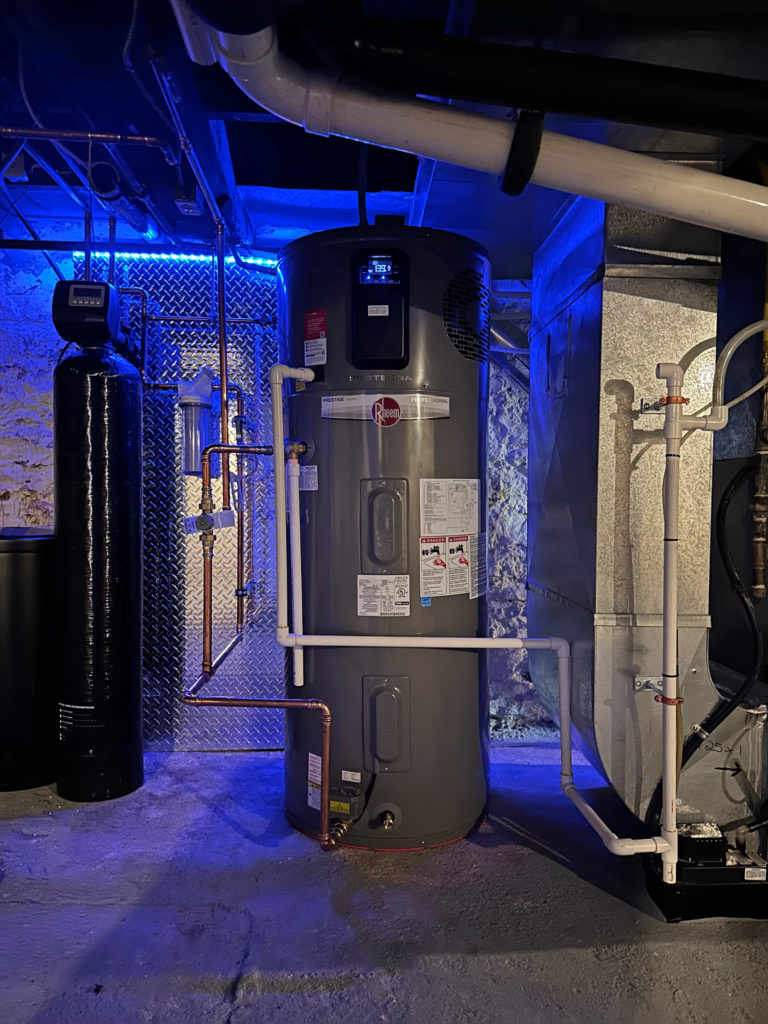
Our new Rheem ProTerra Hybrid Electric Heat Pump Water Heater from their Professional Prestige series.
Where we started
At 18 years old, which is getting up there in terms of water heater lifespan, the old one was on our ‘suspicious persons’ list in the house (along with our furnace, which we’re praying makes it through this winter). The water heater came with the house as a rental, costing us about $114 every 3 months in rental fees alone (wait until you see the math below on why this is SO expensive). Beyond the expensive rental, it was also old, inefficient, and gas-powered. It may have been relatively efficient in its day, but we knew newer models were far more efficient (we just didn’t realize yet HOW much more efficient).
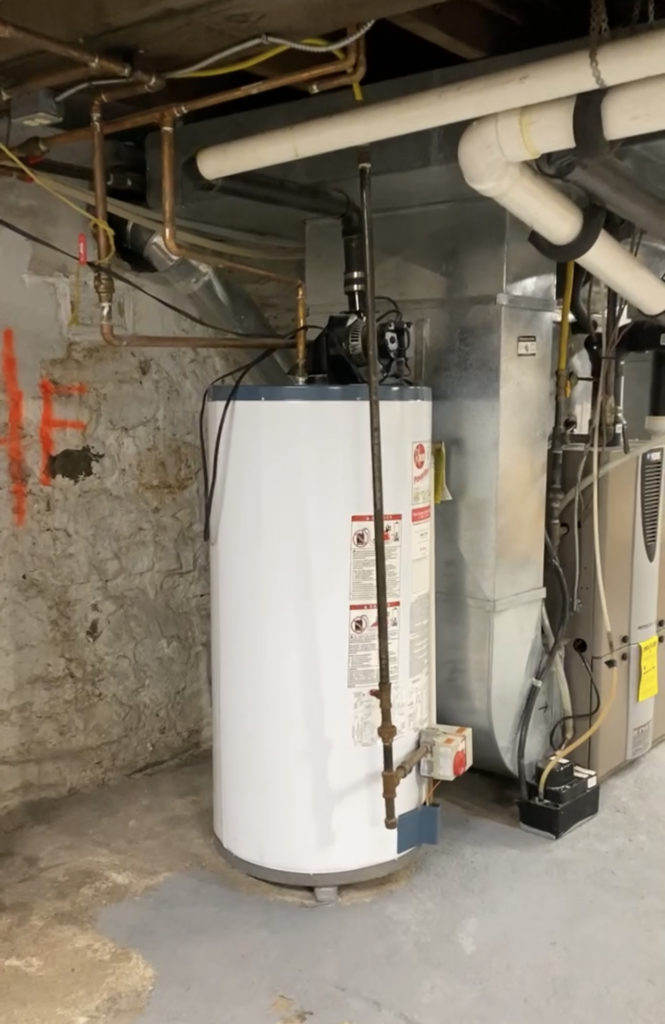
The 18 year old rental water heater in the house when we moved in.
Finally, one day I heard some weird sounds from the tank. Over the next few days, we noticed water starting to drip out of it. If your recall the flood that happened 5 days after we moved in when a defective drainpipe backed up into the basement, you’ll know that even the idea of water leaking in the house is trauma-inducing for us at this point.
It was decided: we needed a new water heater.
We ultimately landed on a Rheem ProTerra Hybrid Electric Heat Pump Water Heater and it is cool.
—
Disclosure: In the early days of our research on water heaters, we independently came across the Rheem ProTerra heater and reached out to them with several questions. In the course of that exchange, we became mutually excited about the opportunity to use our installation as a case study to build awareness about low- and no-carbon water heating. As a result, Rheem did gift us product and installation. There was no obligation for us to endorse Rheem publicly.
—
To understand just how big an improvement the new water heater is, its helpful to understand our base case. Below is the quick math we used to make cents sense of the decision. This is specific to our case, so will net out differently for the setup in your house, but the basic principles will still apply – and some of the numbers will shock you.
Annual Rental Fee Savings: $460
The 18 year old water heater, when purchased back in 2005, likely cost around $500 new. I mentioned above that the quarterly cost (every 3 months) of our rental was about $115, or $460 per year.
Over 18 years of renting, that means the previous owners of the home had spent almost $8,300 over the lifetime of the water heater. Yes, they spent more than 16X what the piece of equipment actually cost outright.
On that principle alone, we were ready to drop it.
In our case, because the unit was so old, the rental company informed us that there were no cancellation fees (how generous of them). I suppose when you’ve charged $8,300 for a $500 piece of equipment, there’s lots of cushion for ‘customer service’ like that.
To be clear, we’re not against fair financing models that allow people to buy new equipment, especially when it can be massively more energy efficient, but models where exorbitant fees are charged are just wrong. Predatory, actually.
So, bottom line for us: buying a new water heater would immediately reduce our annual expenses by $460 in rental savings alone.
Annual Energy Savings: $414
By moving away from gas to electric, we’d find savings right away. Electricity is just more efficient than gas. With electricity, for every unit of energy into a process, more units of energy come out the other side as being captured and / or delivered (something referred to as EROI, or Energy Return on Investment).
Gas, on the other hand, is much less efficient in how it is delivered and used. This is an often misunderstood and overlooked part of how we can transition to a more sustainable world: if we just switched out all our gas equipment, vehicles, and appliances for electric models, we’d require only 40% of all the energy we generate today (1). That’s a 60% reduction without changing lifestyles – driving the same amount, keeping our thermostats where they are, etc. all because electric equipment uses energy more efficiently. This stat is based on US data / infrastructure, which is of course slightly different than Canadian energy infrastructure, but the point still stands.
Right off the bat, then, we knew that based on our sustainability goals for the house, electric was the way to go. It helps us cut one more fossil-fuel-based piece of equipment, putting it on the electric grid instead (which, in Ontario, is relatively clean). In the future, that grid is going to (let’s hope) only get cleaner. More than that, we’d love to add renewable energy to the property in the near future. If solar panels on the roof were generating free electricity to, in turn, power our water heater, electric vehicle, etc. that would be the dream.
Electric water heater it is. Now, here’s where you need to pay attention, because there are two primary types of electric water heaters.
The electric versions that have been out the longest use an electric heating element to make your water hot (think: the element inside your electric kettle). And while these are slightly more efficient than gas models, it’s not a home run – so they’ve mostly been used in places where gas isn’t readily available.
The other type of electric water heater uses a heat pump that can find, compress, and extract heat from the air in our homes, transferring it to the water to make it hot. Heat pumps themselves aren’t new – they’ve been used as heating and air condition devices reliably for decades (we had three at the County House and loved them) – but they are relatively new to water heating. And heat pumps are massively energy efficient.
The Rheem model we opted for actually uses both types of electric heating: an element and a heat pump, hence the name ‘Hybrid’. The element is used as a secondary only-when-needed heat source, turning on in those rare instances where all the hot water has been used in order to turboboost the generation of more hot water quickly. The primary and go-to mode is the heat pump.
This hybrid configuration let us cut the gas without concern about reliability (eco-friendly is nice, but this thing’s job is to deliver hot water in the amounts and times that we need it around the house). It works out to be over 300% more efficient than other water heaters. It uses less energy to operate than a 100W incandescent light bulb!
EnergyStar data suggests that a heat pump water heater will save a household approximately 2760 kWh of energy a year. At Ontario electricity rates, that works out to about $414 annually in savings.
(Note: I wish I had planned to measure our gas water heater usage more precisely in this house first, so I could do a direct comparison. Gas is a lot harder to measure device-to-device because so many pieces of gas equipment are, well, dumb. Pun intended.)
Later in this post I break down the actual energy usage with performance data to-date (an amazing feature of the Rheem app – yes, the water heater is smart and has an app!) and predict what our new annual cost will be for energy to run the water heater.
Before that, I want to talk about one more important piece in the economics: the upfront costs.
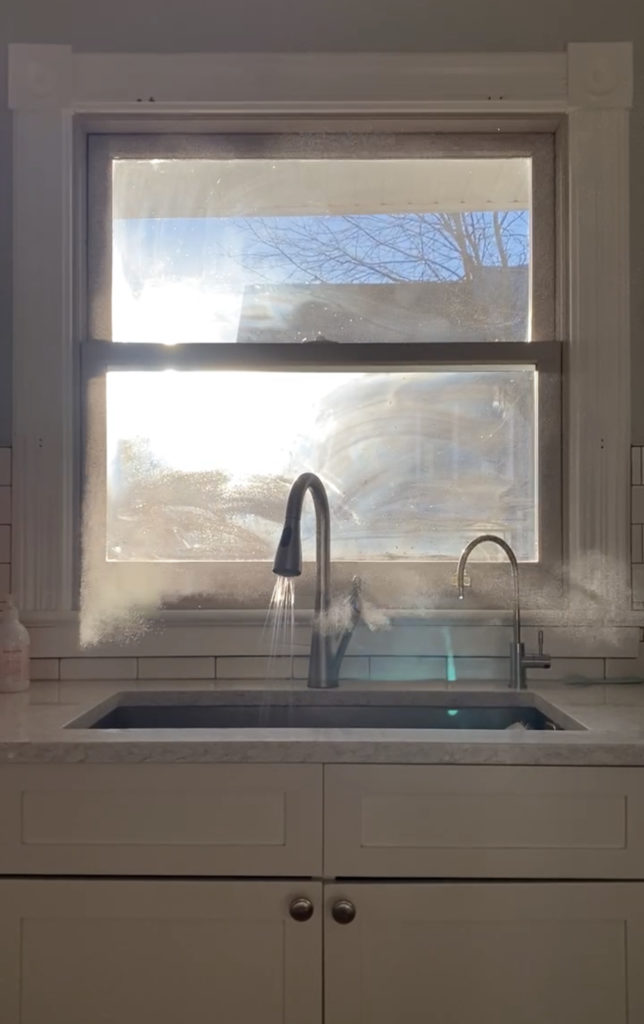
The first morning the water heater was installed, we of course had to check that it was producing steaming hot water.
Water Heater Cost & Payback
We opted for the 65 Gallon version of Rheem’s Professional Prestige Series ProTerra Hybrid Electric Water Heater. While it’s just the two of us here now, there’s a whole separate suite in the house (which we haven’t shown much of yet, but will!) that we plan to reconfigure slightly to become a guest wing of the house for family. It will have it’s own bathroom, guest rooms, and entrance off the main upstairs hallway. In short: our dream is to have this house full of people as often as possible and a bigger water heater – the 65 Gallon – felt like a future-proofed choice as we grow into things here.
You can buy the 65 Gallon version outright for about $3,500. That might seem pricey at first – about 2-3X what a similar gas model might cost – but you’ve got to consider the rental and energy savings, as well as one other important game-changer: rebates.
As part of the Canada Greener Homes Grant (CGHG) – which we also did at the County House – we’ll get $1,000 back!
That means it really only cost us $2,500 out of pocket to do it, – about $1,500 more than a similar gas model.
Because we’re cutting the rental fees and saving so much on the energy, it was interesting for us to look at how long it would take for the savings to cover the extra costs of the unit itself.
- One-time extra cost of $1,500 vs a gas model
- Annual savings of Rental Fees ($460) + Energy Savings ($414) = $874 / year
In other words, in less than two years, we’ll make back the difference. From that point forward, the savings go directly into our old house money pit pockets.
To be clear, an extra $1,500 upfront is no small amount of money. We happened to have a little slush fund we’ve kept aside for house things, knowing we bought a fixer upper that’s going to spring an urgent project on us once in a while. If you don’t have that extra money, there are great programs rolling out in municipalities across Ontario that provide zero interest long-term loans to homeowners for making energy efficiency upgrades. That can sweeten the deal even more. In Halton Hills, where we live, the program has just been piloted with 20 homes (we’re excited to be one of them selected!), which means access to $75,000 for energy efficiency upgrades at 0% interest up to ten years. These are the types of programs that can really make a difference to people making sustainability decisions in their homes. More to come on that program and how we’re going to use it.
Performance-to-date: $0.37/day
Now the fun part. How is this thing actually operating for us so far?
The first thing we’ll say is that it is quiet. For a lot of people, heat pumps are new. When they think of compressors or other pumps, they think of extreme noise levels like your old outdoor A/C unit. Our Rheem water heater has a gentle buzz that we can only hear when we’re in the basement. It really is quiet – much quieter than our gas one actually.
What’s also been quite nice is being able to control the water heater remotely through it’s wifi-enabled app. As an energy geek, I check on the analytics just about every day, which can also inform one of the many different modes you have the option of running the heater in. 90% of the time we it set to Energy Saver mode: it prioritizes the heat pump over the element, and runs according to the strict schedule we’ve set to generate hot water in off-peak hours as much as possible.
Now, the cool part. Let’s look at some actual data from the app since we installed the ProTerra.
In December, the heater used 104.11 kWh of energy to produce our hot water.
In January, we’re sitting at 102.65 kWh of energy at the 26th of the month – suggesting we’ll be at 118 kWh by the end of the month.
- December
- January
Before even diving into the analysis, it’s interesting to just see the visual. It’s obvious we weren’t here for Christmas Day and Boxing Day (see the two day dip in December?).
And that big 8 kWh spike in January? I got up earlier than normal that Saturday to get to a board retreat, meaning the heater likely used the element to quickly produce hot water, whereas normally the heat pump would more slowly produce hot water for another couple of hours before we’re awake and showering. That’s the benefit of the hybrid element. While I was at my all-day meeting, Sarah did a bunch of heavy-duty laundry: work towels, dog beds, you name it. The heater was in overdrive for a good part of the day – makes sense!
Let’s assume our average month is like January, with a spike or two of intense hot water use: 118 kWh.
If we take our Ontario mid-peak rates of 10.2 c/kWh, we’re looking at just $12 in energy each month, or $144/yr. That’s $0.39 per day!
Beyond the Dollars
This is about more than just dollars for us, but seeing the energy savings and payback is a nice way to validate the decisions we’re making about sustainability.
Beyond the economics, there’s a ton of other things about an efficient, smart water heater that were worth it to us:
- Bye-Bye Gas: a ceremonial first cutting of a gas line in this house! Next up: the furnace, stove, and pool heater!
- Leak Detection and Auto Shut-Off: If the tank detects a leak it a) alerts us via the app and b) automatically shuts off the water supply valve. Given our experience with water in the basement, and just how scary that can be, this was a must-have.
- Data! Having the performance data on a real-time basis, whether you’re geeks like us or not, is really cool. It’s made us even more aware of our hot water usage.
- Modes: The heater can run in different modes that we set: Energy Saver (which we use by default), Heat Pump, High Demand (uses the element), and Vacation. It makes you wonder why every water heater ever hasn’t had these modes.
- Scheduling: Whereas mode dictates how the water gets hot, the Scheduling feature lets you control when it gets hot, helpful for eeking out even more energy savings. If Scheduled to be at 140 degrees by 5AM for a shower, it will ensure the water is ready by that time. Paired with Energy Saver mode, this is the ultimate setup!
- Equipment Health: Unlike your old gas heater, where you only know it’s not working once something has gone wrong, the ProTerra gives 4 indicators for health: Is the Leak Sensor connected? Is the Shut-Off Valve open or closed? Is the Heat Pump healthy? Is the Element healthy?
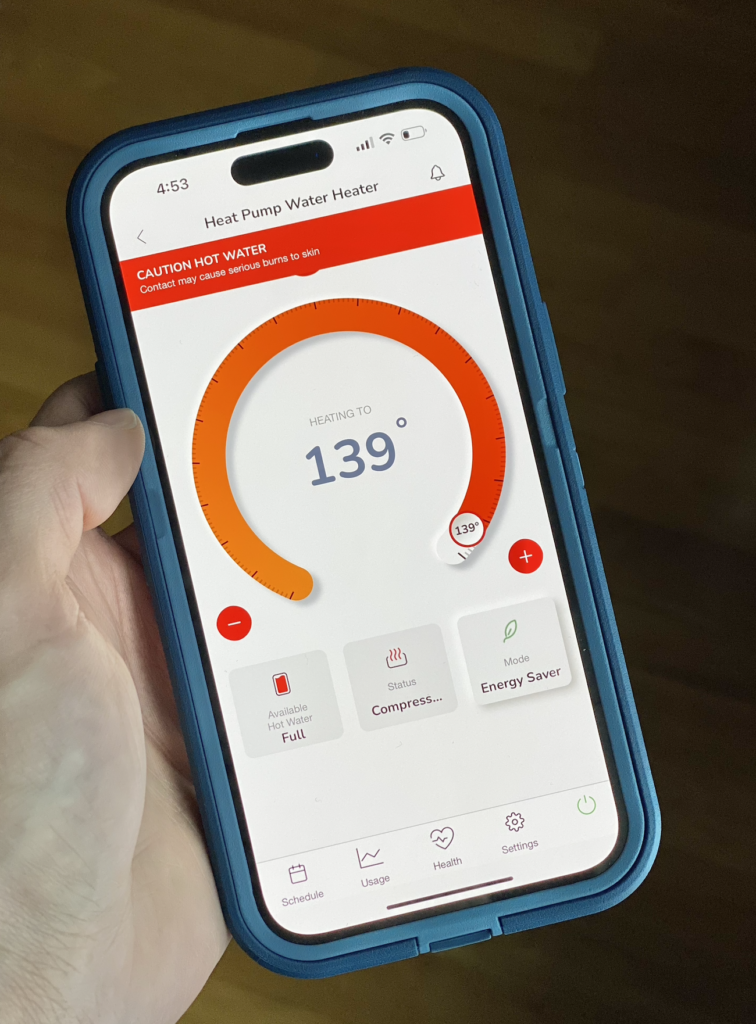
The home screen of the Rheem EcoNet app. Mission control for sustainable hot water!
What I wish the app had:
The fact that the ProTerra comes with an app and all the data is awesome. Like any digital product, it sounds like Rheem is continuing to develop it, and I hope they do. Things I’d love to see in the future, having had the water heater installed for two months now:
- Alerts for Unusual Activity: unusual spikes or dips in activity, that could notify us that something isn’t right or that there might be an opportunity to optimize (if it had alerted us on Dec 25/26 that it sensed no water consumption, it could have kicked into Vacation mode automatically or with our permission to easily conserve more energy)
- Speak in Dollars: it would be neat if Rheem would let us plug in our electricity prices so that we have the option to view data analysis in terms of energy costs, not just energy units
- Forecast: I’d love to get a weekly update on what our predicted energy use and cost will be for the calendar year based on performance to-date, including if that forecast is trending up or down based on recent activity (nothing like a number to motivate us to conserve more)
- Smart Recommendations: if the heater noticed that the element came on every Tuesday for a few weeks because my work schedule changed and required earlier showers, for example, it would be neat if it auto-programmed or suggested a schedule change to ensure hot water is ready in the future at those times
The FAQs
When we shared some glimpses of the Proterra install, we got loads of questions from you, so I’ve gathered the most common ones here our far-from-perfect answers, to the best of our knowledge.
Why not tankless?
Most tankless heaters are gas-powered, which ruled out those models. Any electric tankless options use a heating element in order to heat and deliver water as fast as possible (without a tank for storage). The elements didn’t get us the efficiency or volume & speed of hot water we knew we’d need in this house and most experts we’ve spoken to have agreed.
Isn’t electricity way more expensive than gas?
Gas is cheaper than electricity, yes. But when you find 300-400% efficiency with electric equipment, it is still cheaper to operate overall, even with a higher per-unit energy cost. If you go solar in the future, your per-unit energy cost drops to zero (after investment in the panels – that’s for another blog post).
Isn’t that water heater way more expensive?
It depends on how you look at the economics. In the short-term, it is 2-3X more expensive (about $1500-2000 more). The difference in cost is paid back in less than 2 years in our case (4 years if we weren’t saving all that dough from the rental fees, which is still excellent). Over the lifecycle of the heater – between energy cost and rental fees – we’re saving big time – somewhere around $16,000.
Isn’t it noisy?
No. It has a gentle hum that we can only hear when we’re in the basement.
—
(1) – Saul Griffith, Electrify: An Optimist’s Playbook for our Clean Energy Future
—
Disclosure: In the early days of our research on water heaters, we independently came across the Rheem ProTerra heater and reached out to them with several questions. In the course of that exchange, we became mutually excited about the opportunity to use our installation as a case study to build awareness about low- and no-carbon water heating. As a result, Rheem did gift us product and installation. There was no obligation for us to endorse Rheem publicly.
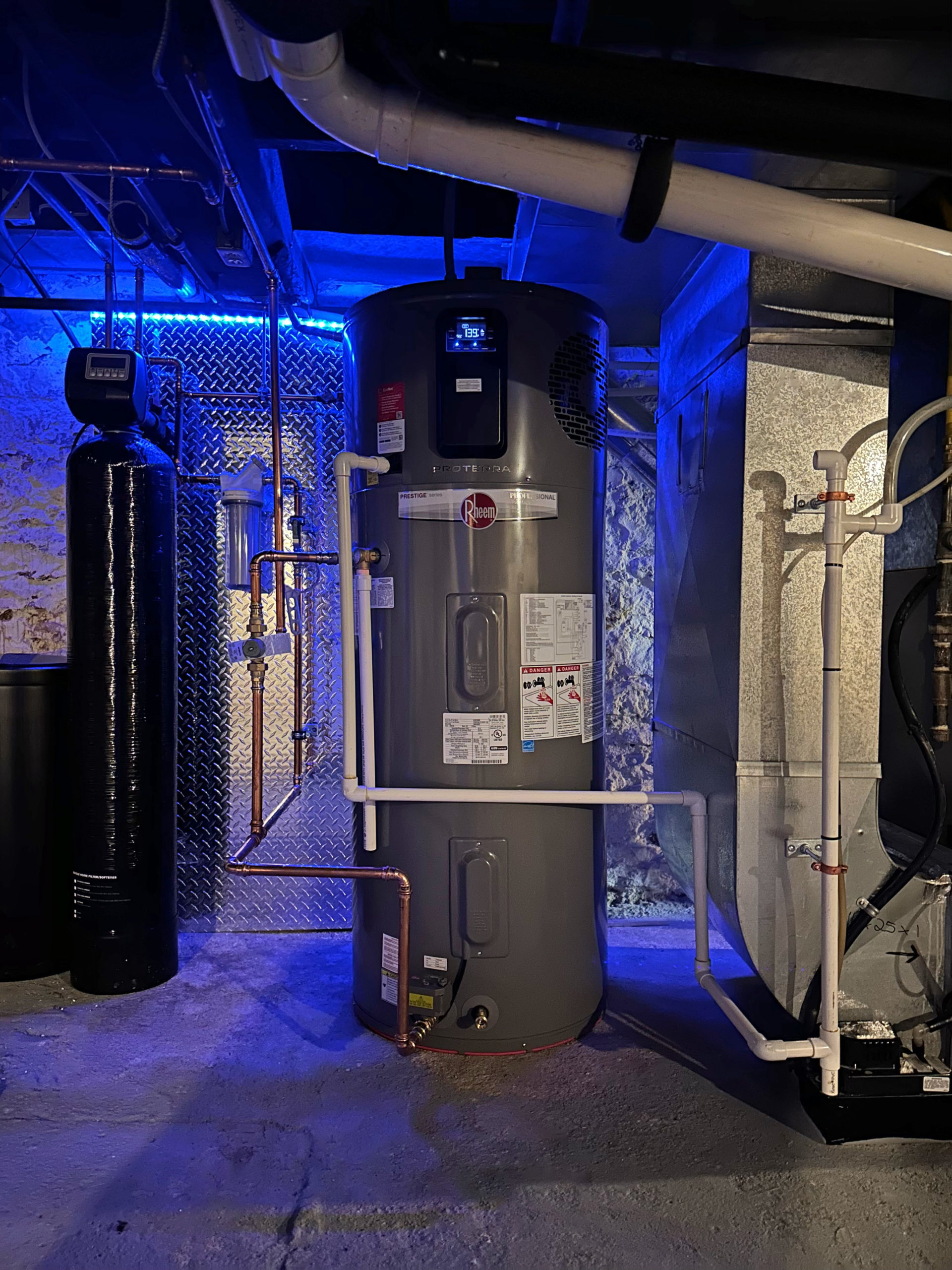
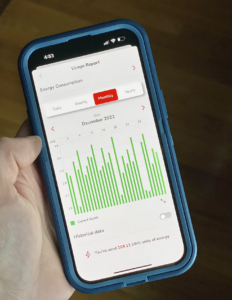
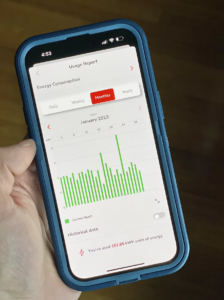
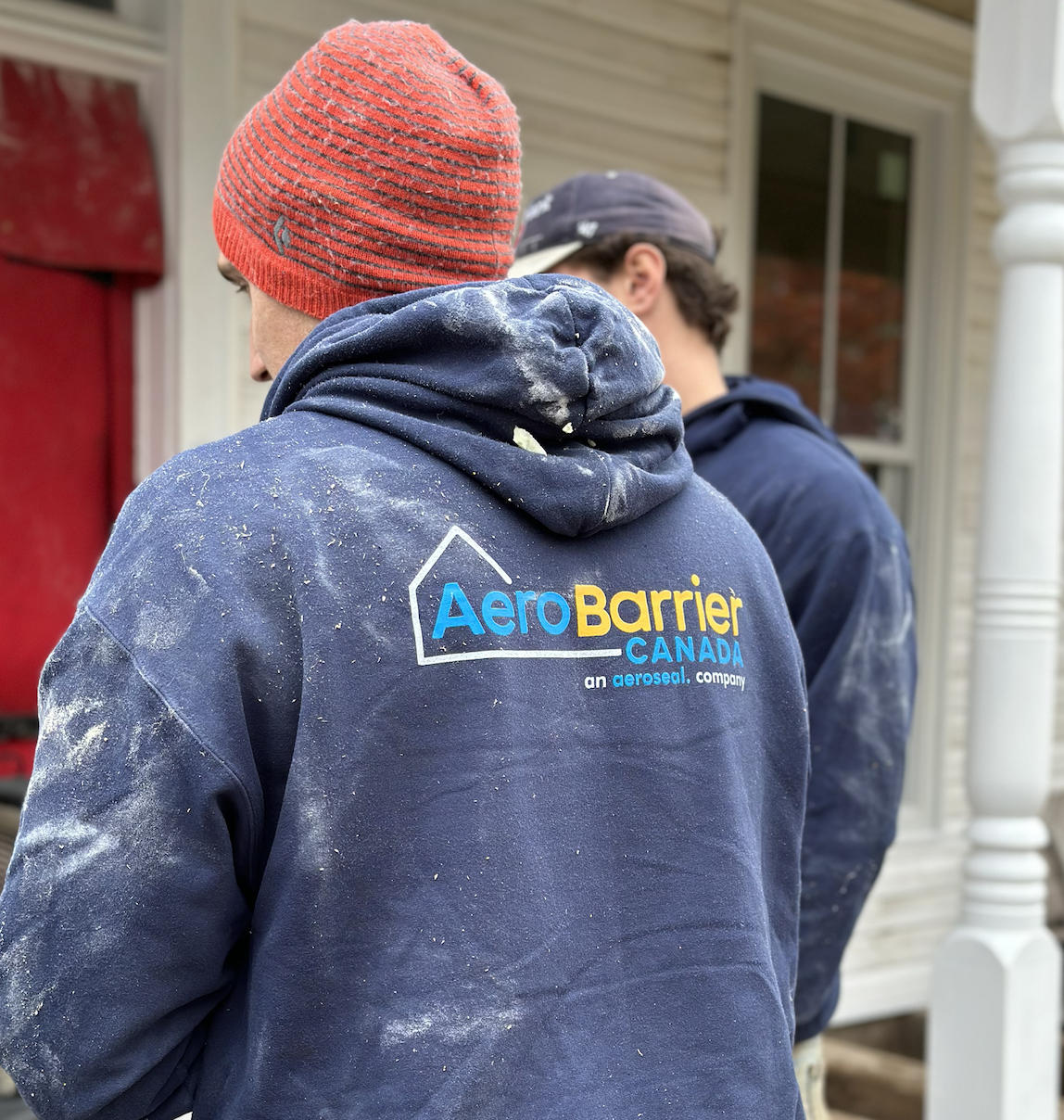





I just geeked out on something I never thought I would. Now I want one 💁🏻♀️
ha! We never expected to create WaterHeaterSavingsQuantifier.xls but here we are!